 |
 |
 |
State agencies face additional budget cuts in FY 2004-2005 |
 |
 |
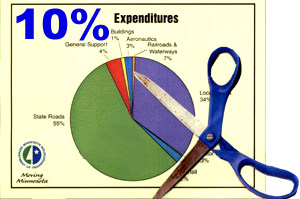 |
The Minnesota Department of Finance has directed all state agencies
to make 10 percent budget reductions to make up for a budget deficit
of $1.6 to $2.7 billion for FY 2004-2005. Illustration by Mark Fischer
and Marsha Storck
|
The Minnesota Department of Finance has directed all state agencies to make
10 percent budget reductions to make up for a budget deficit of $1.6 to $2.7
billion for FY 2004-2005. These reductions not only will include the Trunk Highway,
Airports and General funds, but also State Aid funding for counties and cities,
which was previously exempted.
Cuts to Mn/DOT’s annual budget will have the most effect on the level
of, and our ability to, deliver future construction programs and would mean
more projects added to the recently announced project deferral list, according
to Kevin Gray, chief financial officer.
"Other key programs to be impacted include critically needed funding for
greater Minnesota transit and less investment in the state airports construction
program, as well as State Aid," Gray said.
"Given current staffing levels and the potential loss of 65 percent of
its engineering and technical workforce to retirement and attrition by 2007,
Mn/DOT will not focus on personnel reductions," said Deputy Commissioner
Doug Weiszhaar. "Mn/DOT’s goal is still to retain a skilled workforce."
"Shaping Our Future efforts have helped Mn/DOT operate more efficiently
and effectively in response to the fiscal years 2002-2003 budget deficit,"
Weiszhaar added. "However, state budget projections for FY 2004-2005 have
once again taken a dip, which will require that we fine-tune our budget further
to meet the state’s budgeting needs."
Assistant group directors are charged with developing plans to address these
latest reductions, and identifying the impact of reductions to department performance
targets.
"Because we have already met the challenge and found ways to deliver our
program with limited additional funding, we are ahead of the game," Weiszhaar
said. "The hard work of Mn/DOT employees will help us continue to meet
customer needs and at the same time emphasize our direction of safeguarding
what exists."
By Donna Lindberg
|
back

|
 |
Mn/DOT responds to Star Tribune data requests |
 |
 |
The Minneapolis Star Tribune has made requests to Mn/DOT under the Minnesota
Data Practices Act to examine hundreds of contracts, documents and records containing
thousands of pages of data.
Reporters Patrick Doyle and Dan Browning have received copies of more than
6,000 pages of documents and they have spent much of the past four months examining
thousands of pages of records at Mn/DOT offices. The requests range from information
on large contracts to information about expenditures of as little as $200.
The data requests have required time expenditures by dozens of department employees.
For example, one request to see all correspondence, reports, memos, letters
and other data in paper or electronic form between 28 Mn/DOT employees and 81
legislators since 1999 required the staff time of 13 support staff and 28 managers.
The labor cost to fulfill that single request totaled about $8,500.
In April, Mn/DOT filed a complaint with the Minnesota News Council related
to a Star Tribune story alleging Mn/DOT contracts are illegal. A subsequent
audit by the Legislative Auditor determined the contract noted in the story
was both legal and reasonable.
As do most agencies, Mn/DOT has a designated contact for requests under the
Minnesota Data Practices Act. Should you receive such an inquiry, please forward
it to Linda Bjornberg, director, Management Operations Group.
By Patricia Lund
|
back

|
 |
Quick-drying striping materials promise increased brightness, durability |
 |
 |
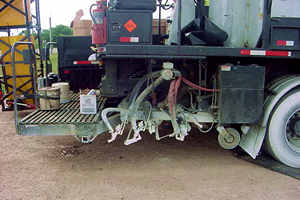 |
The striping machine uses two nozzles to dispense the epoxy materials
and another to apply glass beads to create a highly reflective surface.
Photo by Trudy Kordosky
|
No matter what they say, watching paint dry can be exciting—especially when
it's highway striping paint that can be driven on two minutes after it's applied.
These new "paints" Mn/DOT crews are testing don't actually dry, they cure,
notes Jon Jackels, Mn/DOT's work zone and pavement marking engineer, Traffic
Engineering. "These materials consist of two parts that, when mixed in
the spray gun, react quickly to provide a track-free marking in under two minutes,"
he said.
This short track-free time allows vehicle tires to cross over the line without
having the paint stick to their tires, Jackels said. Full curing takes several
minutes longer, but the initial track-free time enables crews to keep their
operations moving, maximizing safety and productivity.
The traditional epoxy paints Mn/DOT uses take about 30 to 45 minutes to be
track-free under ideal conditions.
The new chemicals being used promise other benefits as well. They keep the
white and yellow stripes brighter longer and reduce workers' exposure to harmful
chemicals. None of the components found in these materials contain volatile
organic compounds listed as harmful by the U.S. Environmental Protection Agency,
a potential benefit for the workers' health and the environment.
The tests being conducted this year involve two new striping materials. 3M
manufactures one; the other is made by North Carolina-based Innovative Performance
Systems.
Private contractors on construction projects in Detroit Lakes, Brainerd and
Duluth districts are installing the 3M product. Mn/DOT striping crews from Metro
and Duluth are using the IPS material.
"Even though the material costs are higher, savings in labor, increased productivity,
and longer life can offset higher material cost," said Brad Lechtenberg,
striping coordinator, Maintenance.
Adds Jackels, "These products offer us more flexibility to select the best
material for each highway segment. This is no longer a one-size-fits-all solution
to providing effective pavement markings 365 days a year in Minnesota. This
will allow us to have brighter, longer-lasting pavement markings that improve
traffic safety while controlling costs."
By Craig Wilkins
|
back

|
 |
New wrinkle for Botox: drug helps keep St. Cloud’s Cindy Asleson on the job |
 |
 |
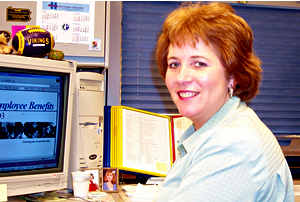 |
Cindy Asleson, administrative specialist in Human Resources in St.
Cloud, has received Botox treatments for 11 years in order to keep her
vocal cords working. Photo by Mike Travis
|
About four times a year, Cindy Asleson gets an injection of Botox, best known
for its ability to mask facial wrinkles. But Asleson, St. Cloud, gets the drug
for a more practical reason—to keep her vocal cords working.
Asleson has a condition known as spastic dysphonia. The properties of Botox
that make it effective against those wrinkles also prevent spasms in her vocal
cords and enable her to speak normally.
Her condition forced her to leave her job as a dispatcher for the St. Cloud
Police Department in 1989. She joined Mn/DOT later that year and found a supportive
work environment and one much easier on her voice.
An administrative specialist in Human Resources, Asleson does back up the front
desk crew on occasion, a job that requires a lot of talking. But if her voice
is weak, her co-workers willingly cover for her, she said.
Asleson has been taking the Botox treatments for 11 years.
Reporter Jeff Passolt from KMSP-TV, Channel 9, learned of her relatively unusual
Botox use during a visit to her clinic at the University of Minnesota and featured
her on a report aired by the station on July 31.
Asleson handled the interview with ease, good humor and good voice.
Noting her clear, strong voice and her opportunity to speak to his TV audience,
Passolt asked Asleson what she might want to say about the state’s growing traffic
congestion problem.
Without hesitating, she said, "I’d love to tell people to talk to the
people we have in the Legislature and maybe we could all get some satisfaction."
By Craig Wilkins
|
back

|
 |
Bob Winter succeeds Dick Stehr as Metro Division engineer |
 |
 |
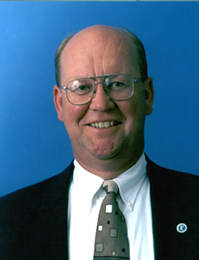 |
Bob Winter has been named Metro Division engineer.
|
Bob Winter was appointed to succeed Dick Stehr as Metro Division engineer.
Winter served as the acting division engineer since January when Dick Stehr
was appointed as director of the Program Support Group.
Winter’s career with Mn/DOT spans 32 years following his graduation from the
University of Nebraska in 1970 with a bachelor’s degree in civil engineering.
In January, 1999 he was appointed as Metro’s assistant division engineer. In
that role he administered division programs and resources and linked division
activities with other Mn/DOT divisions, the Metropolitan Council and other units
of government.
Winter previously served as Metro’s director of rail transit and as its maintenance
operations engineer. He held other positions in project planning, development
and environmental analysis.
As the division engineer, Winter manages the division’s operations and serves
as a key advisor to the commissioner on all aspects of transportation within
the Minneapolis-St. Paul metro area.
By Craig Wilkins
|
back

|
 |
Speakers bureau members take work zone safety message out to the farm |
 |
 |
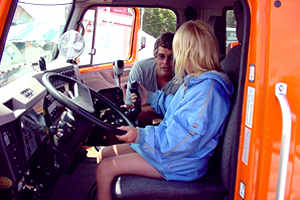 |
Joel Johnson, transportation generalist in Redwood Falls, shows a young
visitor to Farmfest how the joystick controller helps snowplow drivers
manage several operations at the same time. Photo by Sue Barrick
Smith
|
Mn/DOT took its message about work zone safety directly to the state’s agricultural
community at this year’s Farmfest near Redwood Falls. Members of the department’s
work zone safety speakers bureau conveyed the message when they staffed a booth
at the Aug. 6-8 event.
Bureau members from the Willmar, Mankato and Rochester districts handed out
educational and promotional materials, answered questions and demonstrated operation
of a Mn/DOT snowplow during the three-day event.
The effort is part of the bureau’s work to educate Minnesotans about the need
to use increased caution when driving in highway work zones. Bureau members
speak with business, community and school groups to convey Mn/DOT’s work zone
safety message in person throughout the state.
By Craig Wilkins
|
back

|
 |
New on Web: Transportation takes center stage |
 |
 |
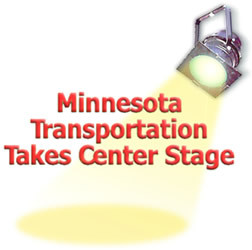 |
Mn/DOT's internal Web page, "Transportation Takes Center Stage,"
will help keep employees up-to-date about the department's major initiatives,
successes and challenges.
|
Whether in the news media or in your neighbor’s backyard, talk these days often
turns to transportation—a debate that’s likely to heat up as political candidates
stake their turf on funding, transit, road construction and other hot transportation
issues.
With the spotlight shining directly on transportation comes the inevitable:
questions posed to employees, at work or home, about Mn/DOT activities.
There’s now a one-stop shop
for transportation information on iHUB (Mn/DOT’s internal Web server) to
help you keep better informed about the department’s major initiatives, successes
and challenges so you can speak confidently and knowledgeably about transportation
issues.
Information on the new "Transportation Takes Center Stage" Web page
is divided into four areas:
-
Big Picture—Links to general information about department initiatives
(e.g., Moving Minnesota, Shaping Our Future), agency accomplishments, census
facts, transportation myths and realities, and financial trends and highlights.
-
Challenges—Links to information (including maps, charts and graphs)
and presentations on specific topics, such as the June 11 news conference
at which the commissioner announced that Mn/DOT would be delaying or dropping
163 projects across the state due to projected funding shortfalls.
For more information about the site, found at http://ihub/information/spotlight.html,
contact Jeanne Aamodt, Communications and Public Relations.
By Chris Joyce
|
back

|
 |
|
 |



